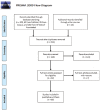How gait influences frailty models and health-related outcomes in clinical-based and population-based studies: a systematic review
- PMID: 33590975
- PMCID: PMC8061366
- DOI: 10.1002/jcsm.12667
How gait influences frailty models and health-related outcomes in clinical-based and population-based studies: a systematic review
Abstract
Aging is often associated with a decline in physical function that eventually leads to loss of autonomy in activities of daily living (ADL). Walking is a very common ADL, important for main determinants of quality of life in older age, and it requires the integration of many physiological systems. Gait speed has been described as the 'sixth vital sign' because it is a core indicator of health and function in aging and disease. We reviewed original studies up to June 2020 that assessed frailty in both longitudinal and cross-sectional observational studies, paying particular attention to how gait is measured in older population and how the gait parameter adopted may influence the estimated frailty models and the health-related outcomes of the various studies (i.e. clinical, cognitive, physical, and nutritional outcomes). Eighty-five studies met the search strategy and were included in the present systematic review. According to the frailty tools, more than 60% of the studies used the physical phenotype model proposed by Fried and colleagues, while one-third referred to multi-domain indexes or models and only 5% referred to other single-domain frailty models (social or cognitive). The great heterogeneity observed in gait measurements and protocols limited the possibility to directly compare the results of the studies and it could represent an important issue causing variability in the different outcome measures in both clinical-and population-based settings. Gait appeared to be an indicator of health and function also in frail older adults, and different gait parameters appeared to predict adverse health-related outcomes in clinical, cognitive, and physical domains and, to a lesser extent, in nutritional domain. Gait has the potential to elucidate the common basic mechanisms of cognitive and motor decline. Advances in technology may extend the validity of gait in different clinical settings also in frail older adults, and technology-based assessment should be encouraged. Combining various gait parameters may enhance frailty prediction and classification of different frailty phenotypes.
Keywords: Aging; Cognition; Diet; Gait analysis; Health status; Physical performance.
© 2021 The Authors. Journal of Cachexia, Sarcopenia and Muscle published by John Wiley & Sons Ltd on behalf of Society on Sarcopenia, Cachexia and Wasting Disorders.
Conflict of interest statement
The authors declared no potential conflicts of interest with respect to the research, authorship, and/or publication of this article.
Figures




References
-
- Ferrucci L, Bandinelli S, Benvenuti E, Di Iorio A, Macchi C, Harris TB, et al. Subsystems contributing to the decline in ability to walk: bridging the gap between epidemiology and geriatric practice in the InCHIANTI study. J Am Geriatr Soc 2000;48:1618–1625. - PubMed
-
- Walston J, Hadley EC, Ferrucci L. Research agenda for frailty in older adults: toward a better understanding of physiology and etiology: summary from the American Geriatrics Society/National Institute on Aging Research Conference on Frailty in Older Adults. J Am Geriatr Soc 2006;54:991–1001. - PubMed
Publication types
MeSH terms
LinkOut - more resources
Full Text Sources
Other Literature Sources
Miscellaneous

